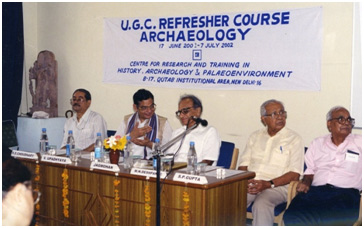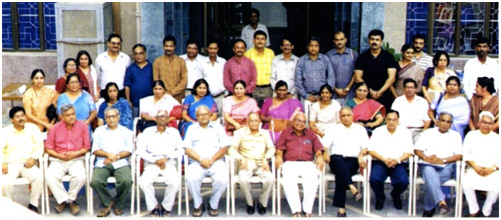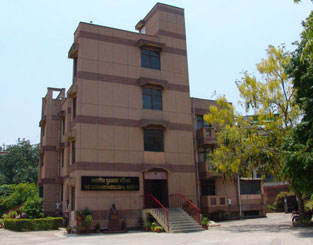Other activities of the Indian Archaeological Society
Excavations
Excavation at Drupad Kila (Kampilya) in District Farrukhabad, Uttar Pradesh (2001)The excavations at Drupad Kila, also known as Kampilya, were started in 2001 as the Indo-Italian Kampilya project of the Indian Archaeological Society in collaboration with Ca Foscari University of Venice, Italy under the direction of G.G. Filippi and K.N. Dikshit. The main objective of the project was to give prime focus on the archaeology of the site. The archaeological remains dated the site between circa 200 BCE to 9th – 10th century CE. Remains of fortification wall of burnt brick, brick-bats platform, walls etc. were noticed at the site. In ceramic assemblages, wheel-made red and grey potteries with medium to thick fabric were noticed. Antiquities including terracotta dabber, fragmentary animal figurines, ghata shaped beads, beads of banded agate and glass bangles, iron nails, knives, corroded objects of copper and one Panchala coin were also yielded from the site.
Reference
Dikshit, K.N. 1999-2000. Report of the First Archaeological Campaign at Drupad Kila (Kampilya). Puratattva 30: 164-172.
Excavation at Kamrej in District Surat, Gujarat (2003)
Kamrej, identified as the Early Historic port and industrial site in District Surat, Gujarat, is located in the estuarine zone of the River Tapi. After the previous investigations in 1935-36 by some archaeologists of the then Baroda State and B. Subbarao and his colleagues of M.S. University, Baroda in 1950s’, the site has been taken up for excavations by the Indian Archaeological Society as a part of their project “History and Archaeology of Indian Ocean Trade” under the directorship of S.P. Gupta in 2003.
Traditionally, Kamrej is known as ‘Kamavati Nagari’ where the Greek record ‘Periplus Maris Erythraei’ of the 1st century CE and Ptolemy’s ‘Geographia’ of 2nd century CE referred Kamrej as ‘village of Kammoni’ and ‘Kammanes’ respectively.
Remains of kilns, burnt brick structures etc. have been unearthed from different layers. Varieties of ceramic assemblages like red polished wares, coarse red wares, plain coarse and burnished red wares, coarse greyish black wares etc. have been yielded from the site. Identification of Kamrej as a port town as well as a manufacturing site has been proved by the presence of amphorae and glazed wares and evidences of crafting of shell into bangles, remains of glass and stone beads, kilns of pottery making and presence of iron slags. Besides, a number of antiquities like terracotta figurines, roof tiles, spindles, a stone sculpture depicting Vishnu and copper coins have also been collected from the excavation at Kamrej. The excavated material remains indicate that ancient Kamrej flourished between 1st – 2nd century CE to 9th - 10th century CE.
Reference
Gupta, S.P., Sunil Gupta, T. Garge. R. Pandey, A. Geetali and Sonali Gupta. 2004. On the Fast Track of the Periplus: Excavations at Kamrej – 2003. Journal of Indian Ocean Archaeology 1: 9-33.
Excavation at Sanjan in District Valsad, Gujarat (2003-2004)
Sanjan, a Parsi/Zoroastrian site on the west coast, is situated on the northern bank of Varoli river or creek in Valsad district, Gujarat. The excavations as a part of project of ICHR namely “Historical and Archaeological Study of Parsi/Zoroastrian Religious Places of Importance in Western India with Special Reference to Bahrot Caves” were conducted under the direction of S.P. Gupta of the Indian Archaeological Society from 2002-2003.
From the excavations in two seasons, remains of burnt brick habitational structure, cattle pen area with rammed cobble floor and a thatched roof, brick well etc. have been unearthed. Various types of ceramics like porcelain, celadon wares, glazed grey or stone wares, glazed pink wares, pink wares, red slipped pink wares, turquoise glazed wares, mica washed red wares, slipped red wares and coarse red wares have also been noticed from the site. The ceramic repertoire of Sanjan suggest that a large number of ceramics were of distinct West Asian/Persian Gulf origins and belonged to the 8th to 9th centuries CE. Among the other antiquities, a large number of beads made of carnelian, and agate, coins made of copper, silver and lead, fragments of glass bangles, terracotta discs and lamps and fragments of cutting ivory have been collected from the excavation. Discovery of a terracotta zoomorphic (elephant-shaped) vessel was the most unique artefact from the second season’s work.
Exposition of buried six human skeletons from the site and the way they had buried revealed the previous burial custom among the local tribal populations of Sanjan.
Reference
Gupta, S.P., Kurush F. Dalal, A. Dandekar, R. Nanji, P. Aravazhi and S. Bomble. 2004. On the Footsteps of Zoroastrian Parsis in India: Excavations at Sanjan on the West Coast – 2003. Journal of Indian Ocean Archaeology 1: 93-106.
Excavation at Kunal, District Fatehabad, Haryana (2016-19)
Kunal, the Pre/Early Harappan site, located in District Fatehabad, Haryana, was re-excavated from 2016-17 to 2018-19 as a project of the Indian Archaeological Society under the direction of B.R. Mani, Director General of National Museum in collaboration with the Department of Archaeology and Museums of Haryana with an objective to co-relate and compare cultural evolution with the nearby oldest Harappan site Bhirrana and to get more accurate chronology of the site. The C – 14 dates have proposed the antiquity of the site to about 6th millennium BCE. Earlier, the site was excavated by the Department of Archaeology and Museums, Haryana under the supervision of J.S. Khatri and M. Acharya in 1985-86 and from 1991-92 to 1994-95. Evidence of dwelling pits with aligned mud bricks could be noticed in trenches. Hakra wares, bichrome red wares, silver crowns and other ornaments etc. have been discovered from the excavation.
From the excavation in 2016-17, a layer with hearths, floors and potsherds is noticed below the early layer which was noticed from previous excavation and this evidence feels to re-examine the chronology of the site. Besides, a workshop area with traces of finished and unfinished steatite beads making is also noticed from the site. A large varieties of Hakra wares, red wares, black on red wares, and Painted Grey Wares etc. with various shapes and size, terracotta cakes, terracotta beads, terracotta animal figurines including one with pasted steatite beads, steatite beads, faience beads and bangles, gamesmen, stamps, three small gold beads, copper objects etc. were yielded from the excavation. The deposit continued upto the depth of 4.80m in the trench YC1, Quadrant 2. Various sizes of mud-bricks were noticed from Harappan and other levels in the ratio of 1:2:4, 1:2:3, 1:3:4 and 1:3:5.
In 2018-19 amongst stone objects, a stone seal with a square divided into quadrants and a hole in the knob, chert stone weight, chert blade, bone points, semi-precious stone and faience beads and beautifully painted pottery were found. An interesting feature in the stratigraphy of the site was added with the stratified deposit of Painted Grey Ware found in association with black-and-red ware and black slipped ware.
Workshops and Training programmes
1. The first Refresher Course in Archaeology (2002)
The University Grants Commission (UGC) asked the Indian Archaeological Society to organize a Refresher Course in Archaeology to the Lecturer/Asstt. Professors from different Universities. The first Refresher course in Archaeology from 17th June - 7th July, 2002 was inaugurated by the Hon’ble Minister for Tourism and Culture Shri Jagmohan ji in the presence of Prof. Yash Pal a well known scientist and Dr. S.P. Gupta, Director of the Refresher Course, honoured Guests and teacher participants. Thirty lecturers from different universities joined the Refresher Course in Archaeology. In its efforts to improve the quality of higher education in India, the UGC has been recognising the reputed departments in various disciplines in the universities to conduct refresher courses for university and college teachers. The lecturers are required to successfully participate in four courses to be eligible for promotion to Selection Grade and Senior Scale. Hence, such courses are greatly in demand by lecturers.

Dr. S.P. Gupta, Shri M.N. Deshpande, former D.G. Archaeological Survey of India, Hon’ble Shri Jagmohan ji, Minister for Tourism and Culture, Prof. Vachaspati Upadhyaya, V.C., Lal Bahadur Shastri Rashtriya Sanskrit Vidyapeetha and Dr. R.D. Choudhury, D.G., National Museum.

Participants and resource persons of the first Refresher course in Archaeology
2.The Engineering Aspects of Indus Cities
Main stream engineers hardly nurtures interest in ancient history, but most ancient period of Indian history going into the Harappan period offers many challenges in tracing and appreciating the development of civil engineering in the country. Keeping this in view, as a first step towards this direction the Indian Engineering Heritage (Civil) Group of the Indian National Academy of Engineering (INAE) and the Indian Archaeological Society held a one day workshop on ‘The Engineering Aspects of Indus Cities’ on 14th March, 2009. The civil engineering professors from different IITs and leading archaeologists who have excavated and investigated Indus Cities interacted.
3. Conservation and Management of Persian, Timurid and Mughal Architecture with Archaeological Survey of Indian and UNESCO
A joint workshop on "Conservation and Management of Persian, Timurid and Mughal Architecture in collaboration with the Archaeological Survey of India and UNESCO held between 5th – 13th April, 2003. As a part of this workshop, lecture on Periodic Reporting and Updating the Statement of Outstanding Universal Value for World Heritage Site and World Heritage Property Extension and or Serial Nominations: Process and Sub-regional Co-operation was delivered by Dr. Roland Lin, UNESCO programme specialist for culture in IAS lecture hall on 7th April, 2009.
4. Training programme on “Capacity Building amongst the Heritage Managers of North-Eastern Region”
This training programme was organized by the Indian Archaeological Society, New Delhi jointly with the Srimanta Sankaradeva Kalashetra Society, Guwahati from 21st – 28th February, 2011.This programme was financially supported by the Ministry of Development of North-Eastern Region, Government of India. The main objective of the programme was “Capacity Building amongst the Heritage Managers of North-Eastern Region”, and also to create an awareness to promote and motivate the people towards the preservation of the rich cultural heritage of Northeast India. Formal and informal training programme in this aspect will help to eliminate all negative elements and facilitate the community to enrich their technical knowledge and to identify the authentic objects from the fake.
National Seminar on “Science of Conservation of inbuilt Heritage”
The Indian Archaeological Society organized a seminar on the “Science of Conservation of inbuilt Heritage” from 28th October, 2013 to 30th October, 2013 under the auspicious of Northeast Council with exclusive support of the Government of Manipur at Imphal (Manipur). Thirty participants came from the different parts of the eastern India. Scholars of repute were invited to deliver the lectures.
International Seminar on “Heritage, Visuality and Museology”
An International Seminar on ‘Heritage, Visuality and Museology’ was jointly organized by Department of Museology and the Department of Archaeology, University of Calcutta on 4th and 5th December, 2013. The Seminar was held in the auditorium of the Centre for Social Sciences and Humanities, Alipore Campus, Kolkata. The seminar was attended by delegates from different countries like Sri Lanka, Bangladesh, Thailand, etc.
International Seminar on “Dynamics of Museum and Social Inclusion”
It was jointly organized with P.C. Mahalanobis Memorial Museum & Archives, Kolkata from 26th February to 27th February, 2015.
National Seminar held at Rajiv Gandhi University, Itanagar, Arunachal Pradesh
The Indian Archaeological Society organized three days National Seminar on "Archaeology, History, Art, Museums and Folklores of the Northeast India" from 20th to 22nd April, 2017 in collaboration with Rajiv Gandhi University, Itanagar, Arunachal Pradesh and National Museum Institute, New Delhi. Shri Pema Khandu, the Hon'ble Chief Minister of Arunachal Pradesh, grace the occasion as Chief Guest and inaugurated the seminar with a speech on Arunachal Pradesh, a treasure trove of nature in the north-east India with pilgrimage centres and Buddhist monastery at Twang with evergreen forest and habitations of major tribes and sub-tribes with their handicraft and also talked about the importance of this seminar which may be the platform for the young researchers to explore the neglected past of this region.

The Indian Archaeological Society
B-17, Qutab Institutional Area
New Delhi – 110016, India
Phone: +91-011-26523728, 26852695
Fax: +91-011-26960654
E-mail: ias_newdelhi@yahoo.co.uk iasnewdelhi1967@gmail.com iasnewdelhi@rediffmail.com
Number of
Total Visitors
